

EXPO PRIVATE. PRIVATE. Carnegie Robotics. Tartan Rescue Team. Modular Snake Robots - CMU Biorobotics. HDT Robotics. Ground Penetrating Radar Equipment - GSSI. Florida Institute for Human and Machine Cognition (IHMC) Clearpath Robotics - Rugged All-Terrain Mobile Robots for Research. Boston Dynamics: Dedicated to the Science and Art of How Things Move. General Dynamics C4 Systems - Home. Google. Space, Stars, Mars, Earth, Planets and More - NASA Jet Propulsion Laboratory.
Corporation: Robots that Make a Difference. Johnson Space Center Home. Otherlab! TORC Robotics - Unmanned Vehicle Solutions and Automation. Robot Technology Solutions. Sandia National Laboratories: Exceptional Service in the National Interest. ATV RANGER RZR Snowmobile Official Website. Information - Important Notice. Robotics. Home - TakkTile. Data, Information, Knowledge, Wisdom: The concept... - Futurescope.
EXPO PUBLIC. The National Guard - Official Website of the National Guard. USAR South Florida Task Force 2. USFIRST.org. StarBot Inc. Tactically Expandable Maritime Platform (TEMP) During natural or manmade disasters, the U.S. armed forces, with rapidly deployable sealift, airlift, logistics, and medical care capabilities, may be called to supplement lead agencies or organizations providing humanitarian assistance and disaster relief support.
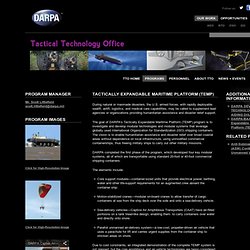
The goal of DARPA’s Tactically Expandable Maritime Platform (TEMP) program is to investigate and develop modular technologies and modular systems that leverage globally used International Organization for Standardization (ISO) shipping containers. The vision is to enable humanitarian assistance and disaster relief over broad coastal areas without dependence on local infrastructure, using unmodified commercial containerships, thus freeing military ships to carry out other military missions. DARPA completed the first phase of the program, which developed four key modular systems, all of which are transportable using standard 20-foot or 40-foot commercial shipping containers. TEEX : Texas A&M Engineering Extension Service. Hillsborough County - Sobre. OSRF - Home. EXPO EDU. The Johns Hopkins University Applied Physics Laboratory.
Kairos Autonomi: Universal Agnostic Autonomy Systems for Existing Vehicles and Vessels. Worcester Polytechnic Institute (WPI) -TOHOKU UNIVERSITY- Invent the Future. Nagaoka University of Technology. Drexel University. Inspiring students, one robot at a time. Teams. A TRACK. Tartan Rescue. Carnegie Mellon University-NREC is developing the CHIMP (CMU Highly Intelligent Mobile Platform) robot for executing complex tasks in dangerous, degraded, human-engineered environments.
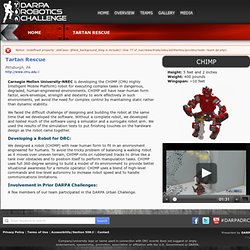
CHIMP will have near-human form factor, work-envelope, strength and dexterity to work effectively in such environments, yet avoid the need for complex control by maintaining static rather than dynamic stability. We faced the difficult challenge of designing and building the robot at the same time that we developed the software. Without a complete robot, we developed and tested much of the software using a simulator and a surrogate robot arm. We used the results of the simulation tests to put finishing touches on the hardware design as the robot came together. Developing a Robot for DRC: We designed a robot (CHIMP) with near human form to fit in an environment engineered for humans. Involvement in Prior DARPA Challenges: A few members of our team participated in the DARPA Urban Challenge. RoboSimian. Jet Propulsion Labs is building RoboSimian, a simian-inspired, limbed robot that will use deliberate and stable operations to complete challenging tasks under supervised teleoperation.
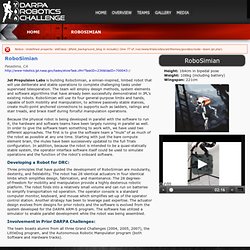
The team will employ design methods, system elements and software algorithms that have already been successfully demonstrated in JPL’s existing robots. RoboSimian will use its four general-purpose limbs and hands, capable of both mobility and manipulation, to achieve passively stable stances, create multi-point anchored connections to supports such as ladders, railings and stair treads, and brace itself during forceful manipulation operations. Because the physical robot is being developed in parallel with the software to run it, the hardware and software teams have been largely running in parallel as well. In order to give the software team something to work with, we have used two different approaches. The first is to give the software team a “mule” of as much of the robot as possible at any one time. Team THOR. Virginia Tech is developing THOR, a Tactical Hazardous Operations Robot, which will be state-of-the-art, light, agile and resilient with perception, planning and human interface technology that infers a human operator’s intent, allowing seamless, intuitive control across the autonomy spectrum.

The team will emphasize three essential themes in developing THOR: hardware resilience, robust autonomy and intuitive operation. SCHAFT. DRC-HUBO Team. NASA JSC Team Valkyrie. NASA Johnson Space Center is developing a next-generation humanoid robot and control paradigm capable of performing dynamic, dexterous and perception-intensive tasks in a variety of scenarios.
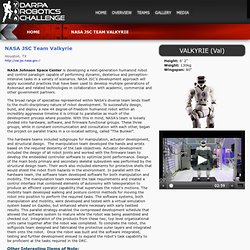
NASA JSC’s development approach will apply successful practices that have been used to develop multiple generations of Robonaut and related technologies in collaboration with academic, commercial and other government partners. The broad range of specialties represented within NASA’s diverse team lends itself to the multi-disciplinary nature of robot development. B/C TRACK. Team HKU. Team TROOPER. Team TRACLabs. Team ViGIR. MIT. Early on, we organized across system aspects: perception, interface, planning & control, network, infrastructure.
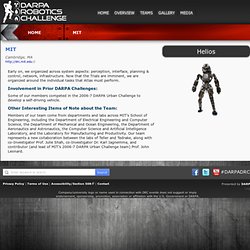
Now that the Trials are imminent, we are organized around the individual tasks that Atlas must perform. Involvement in Prior DARPA Challenges: IHMC Robotics. WPI Robotics Engineering C Squad (WRECS) D TRACK. Chiron. Kairos Autonomi has utilized existing technology as a benchmark for new technology development.
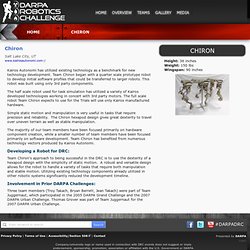
Team Chiron began with a quarter scale prototype robot to develop initial software profiles that could be transferred to larger robots. This robot was built using only 3rd party components. The half scale robot used for task simulation has utilized a variety of Kairos developed technologies working in concert with 3rd party motors. The full scale robot Team Chiron expects to use for the Trials will use only Kairos manufactured hardware. Simple static motion and manipulation is very useful in tasks that require precision and reliability.
The majority of our team members have been focused primarily on hardware component creation, while a smaller number of team members have been focused primarily on software development. Intelligent Pioneer. Team Mojavaton. Mojavaton consists of 6 team members that worked on the design and construction of the robot hardware.
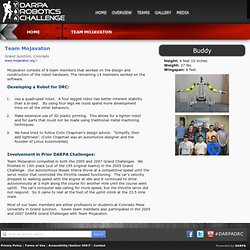
The remaining 14 members worked on the software. Developing a Robot for DRC: Use a quadruped robot. A four legged robot has better inherent stability than a bi-ped. By using four legs we could spend more development time on all the other behaviors.Make extensive use of 3D plastic printing. Team KAIST.